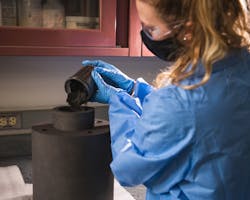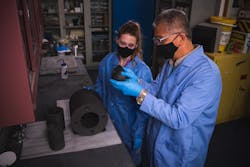Hot-Pressing Manufacturing Formula Produces High-Performance Parts
Scientists have developed a novel pseudo-hot-isostatic-pressing (P-HIP) manufacturing method that produces industrial components that emerge very close to their final shape.
The P-HIP technology enables the manufacturing of complicated shapes using uniaxial hot pressing with near-net shape capability, noted the researchers at the Los Alamos National Laboratory. In addition to producing shapes that are close to final, the patent-pending method is touted as a more efficient way to produce reliable components.
Techniques for hot-pressing ceramics and metal powders have been around for decades. Typically, hot pressing involves the application of external pressure, applied from top and bottom, on materials under high heat through a simple shaped die. Both high temperatures and hydraulic pressure are required to fabricate dense, non-oxide monolithic ceramics and their composites. The technique is suitable for simple shapes, such as cylinders, blocks, discs or flat plates.
“Little improvement has been implemented since this technique was initially developed, and limitations such as the performance quality and variety of shapes that can be made are persistent challenges, particularly in uniaxial hot-pressing,” said Chris Chen, a researcher in the Sigma Fabrication Manufacturing Science group at the Laboratory.
Chen and his team described their new method as “transformational” because it can refine shapes in new ways. A thin-walled Certifiable Test Object, for instance, would require additional energy- and time-intensive machining. They noted that P-HIP also improves upon pressureless sintering, a commonly used technology for manufacturing components without any external pressure. Compared to the P-HIP process, components produced by pressureless sintering tend to have higher porosity, or void space, which contributes to lower performance.
Chen’s team developed a near-net-shape P-HIP to produce high-performance ceramic or metal with a combination of important properties: versatile and complicated shape, high density, uniform density distribution and minimal amounts of machining required. The improved mechanical properties, the researchers noted, provide “greater strength to withstand severe stress and survive longer, better electrical properties offer better conductivity, and have stronger magnetic properties.”
The P-HIP can outperform other manufacturing technologies, including conventional hot-pressing, slip-casting, cold-isostatic-pressing, extrusion, injection molding and additive manufacturing. “P-HIP technology delivers high added-value and will increase the performance and reliability of critical components for the nation and for a wide array of industries,” Chen said.
The research team described the technique as follows: “The P-HIP technique uses graphite flakes, hexagonal boron nitride powder, or other appropriate solid lubricant to replace the solid graphite punch used in conventional hot pressing. The solid lubricant can easily slide, redistributing stress from high-stress concentration areas to low-stress concentration areas, a self-stress-relief action.
The graphite flake or hexagonal boron nitride powder lubricants can withstand temperatures up to 3,000°C. The method provides substantially uniform pressure that can create near-net-shape parts that also have high density distributed more evenly through the whole part.”
This approach results in stronger and more reliable parts with fewer rejections, noted the scientists, who have worked to refine the technique over several years at the Advanced Ceramics Processing Laboratory at Los Alamos. The new method also saves energy, time and cost on finish machining.
They noted that P-HIP is best suited to materials that either have a prohibitive cost for failure (such as oil and drilling parts, turbine engines and nuclear reactor components) or cannot afford to fail at all (e.g., soldiers’ head protection, airplane engines and satellite equipment).
The development of P-HIP was supported by the Department of Energy Office of Energy Efficiency and Renewable Energy.
About the Author

Rehana Begg
Editor-in-Chief, Machine Design
As Machine Design’s content lead, Rehana Begg is tasked with elevating the voice of the design and multi-disciplinary engineer in the face of digital transformation and engineering innovation. Begg has more than 24 years of editorial experience and has spent the past decade in the trenches of industrial manufacturing, focusing on new technologies, manufacturing innovation and business. Her B2B career has taken her from corporate boardrooms to plant floors and underground mining stopes, covering everything from automation & IIoT, robotics, mechanical design and additive manufacturing to plant operations, maintenance, reliability and continuous improvement. Begg holds an MBA, a Master of Journalism degree, and a BA (Hons.) in Political Science. She is committed to lifelong learning and feeds her passion for innovation in publishing, transparent science and clear communication by attending relevant conferences and seminars/workshops.
Follow Rehana Begg via the following social media handles:
X: @rehanabegg
LinkedIn: @rehanabegg and @MachineDesign



